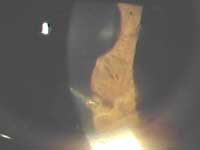Wartime incidence of eye injuries surging, medical officer says
Blast-wave contusions and blast fragmentation account for 68% to 78% of ocular trauma.
ROME – The incidence of eye injuries during military operations has increased exponentially over the past decades, according to data presented at the meeting of the International Society of Ocular Trauma. Compared with World War I and World War II, more recent conflicts, such as the Gulf War and the Croatian War, have reported about a sixfold increase in the number of injuries to the ocular apparatus.
Statistically, the eye is one of the most frequent targets of wartime injuries.
“Although the exposed surface of the eyeball constitutes only 0.1% of the frontal body silhouette, the incidence of ocular injuries in warfare is about 20 to 50 times higher than could be expected,” said Giorgio Romani, MD, head of the ophthalmology unit at the Military Hospital in Rome.
This is due, he said, to the lateral curvature of the orbital margin, which extends laterally on the exposed surface of the eye, thereby increasing the risk of injury from the sides.
In addition, the eyes have a preferential exposure during military operations.
|
|
Images: Romani G |
The increased incidence of injuries in recent years is because of the latest developments of war techniques and weapons.
“Improved munitions, which create increasingly smaller fragments, and also nonconventional or unknown munitions such as those used in terrorists’ explosions, have multiplied the number of blast injuries and fragment injuries in the eye apparatus,” said Massimo Cantarini, MD, senior consultant of ophthalmology and head of the neurosensory department of the Military Hospital in Rome.
Fragment injuries are particularly common in trench warfare, where artillery activities inflict not only wounds through fragments of bombs, shells and shrapnel, but also by innumerable splinters of stones, cement and sand.
Also, the use of anti-personnel mines account for a high number of eye injuries in some areas. In warfare, mines represent 9% to 15% of all munitions-related causes of ocular injuries.
“On the whole, blast-wave contusions and blast fragmentation account for 68% to 78% of warfare ocular trauma,” Dr. Romani said.
A different type of damage to the eye is related to the laser, which is used routinely in modern battlefields for target designators, range finders and radar warning. In the future, the incidence of laser-caused eye injuries could significantly grow, as the threat of lasers as anti-personnel devices by enemy forces is “a real and increasing threat,” Dr. Romani said.
 |  |
| Patient injured during terrorist explosion in Nassirya. No intraocular foreign bodies were found. The blast wave caused pupillary shock and choroidal hemorrhage, which resolved spontaneously within 3 months. | |
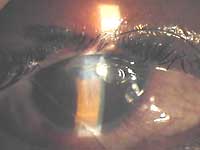 | 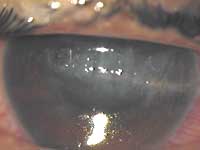 |
| Same explosion in Nassirya. Fragments of stones and sand from the lateral side of the eye caused corneal laceration. | |
 |  |
| Patient with metallic intraocular foreign body perforating the cornea and causing significant inflammatory reaction. The patient was treated in Rome following an explosion in Afghanistan. The long journey exposed the patient to a high risk of metallosis. | |
Blast injuries
The detonation of an explosive device causes a high-speed chemical decomposition of a solid or a liquid into a gas. The explosion creates a wave of high pressure that moves at a speed of 10,000 m/sec to 30,000 m/sec.
“The rapid decrease in pressure that follows sucks back, into the explosion area, fragments of the explosive device, along with debris and objects from the surrounding ground,” Dr. Romani said. “Ocular injuries are usually caused by a combination of two factors: the blast wave, which causes a direct contusion of the eye of variable severity according to the proximity of the explosion, and the fragments that, launched into the air like projectiles, cause various types of penetrating injuries depending on speed, size and shape of the fragments.”
He said the proportion of eye injuries over the total number of explosion-related traumas increases with the distance from the site of the explosion (0 m to 20 m = 2%, 50 m to 80 m = 14%).
He illustrated the emblematic case of one patient who had been injured in Sarajevo by a mine exploding at a distance of 1 m. The patient presented a series of bilateral ocular lesions. In the left eye, a variety of foreign bodies had penetrated and severely injured the cornea, the lens and the vitreous. In the right eye, there were no foreign bodies, but the blunt trauma caused by the shockwave had caused macular edema and diffused retinal hemorrhages.
“Over the years, we have been able to identify the main clinical features of ocular blast injuries. They usually present a wide spectrum of symptoms, are more often bilateral with a high presence of intraocular foreign bodies and a high frequency of concomitant associated injuries. Practically every type of closed and open globe lesion may be present, in various combinations,” Dr. Romani said.
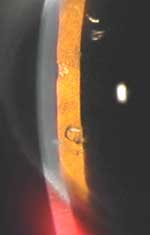 | 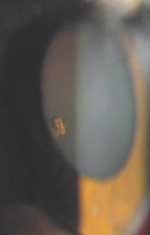 | 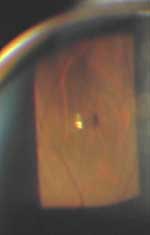 |
| Terrorist explosion in Nassirya. A small but sharp fragment perforated the cornea, the iris and the lens. | ||
Urgent, complex care
The extent of the damage caused by intraocular foreign bodies is not only determined by mechanical factors, such as speed, shape and size, but also by the composition of the intraocular foreign bodies. Reactive metals such as copper, iron, lead and zinc can cause metallosis, with sequelae of irreparable damage, which may manifest themselves years later. Wood and other organic foreign bodies, including human tissue fragments, can cause fulminant endophthalmitis.
“Reactive intraocular foreign bodies should be removed immediately, and this is not always possible during military operations,” Dr. Romani said.
In addition, the treatment of ocular injuries during military operations frequently requires a multidisciplinary medical team.
“Explosions usually bring us not just one, but a number of urgent cases,” Dr. Cantarini said. “We have limited time available to provide proper care. The damage is extended to different parts of the eye and there are many associated injuries in other parts of the body. The only way we have to minimize the damage is by wearing appropriate ‘eye armor.’ Specific shock-resistant eyewear that protects also the lateral side of the orbital entrance is mandatory.”
For more information:
- Giorgio Romani, MD, and Massimo Cantarini, MD, can be reached at Policlinico Militare di Roma, Piazza Celimontana 50, I-00184, Rome, Italy; fax +39-06-70196610; e-mail: ascoyni@hotmail.com.
- Michela Cimberle is an OSN Correspondent based in Treviso, Italy, who covers all aspects of ophthalmology. She focuses geographically on Europe.


